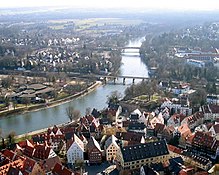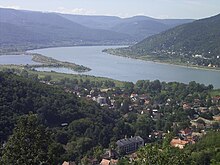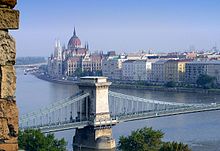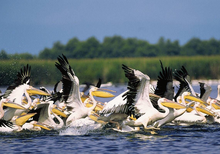Danube: Difference between revisions
Tag: section blanking |
|||
| Line 145: | Line 145: | ||
On October 7, 2010, a toxic red sludge that burst out of a Hungarian aluminum factory's reservoir entered the Danube, threatening an ecological disaster. The pH content of the red sludge entering the Danube had been reduced to the point where it was unlikely to cause further environmental damage. It had been tested earlier at a pH level of 13 and now was down under 10, and no dead fish had been spotted where the slurry was entering the Danube.<ref name=Danube>[http://news.yahoo.com/s/ap/eu_hungary_sludge_flood ''Toxic red sludge has reached the Danube''].</ref> |
On October 7, 2010, a toxic red sludge that burst out of a Hungarian aluminum factory's reservoir entered the Danube, threatening an ecological disaster. The pH content of the red sludge entering the Danube had been reduced to the point where it was unlikely to cause further environmental damage. It had been tested earlier at a pH level of 13 and now was down under 10, and no dead fish had been spotted where the slurry was entering the Danube.<ref name=Danube>[http://news.yahoo.com/s/ap/eu_hungary_sludge_flood ''Toxic red sludge has reached the Danube''].</ref> |
||
==Name== |
|||
The Danube was known in [[Latin]] as {{lang|la|Danubius, Danuvius, Ister}}, in [[Ancient Greek]] as Ίστρος (''Istros'') . |
|||
The [[Dacian language|Dacian]]/[[Thracian language|Thracian]] name was Τάναις/''Donaris'' / ''Donaris'' (upper Danube) and ''Istros'' (lower Danube).{{Citation needed|date=October 2010}} |
|||
The name ''Dānuvius'' is presumably a loan from Celtic ([[Gaulish language|Gaulish]]). It is one of a number of river names derived from a Indo-European word ''*dānu'', apparently a term for "river", but possibly also of a primeval cosmic river, and of a river goddess (see [[Danu (Asura)]]), perhaps from a root ''*dā'' "to flow/wift, rapid, violent, undisciplined." |
|||
Other river names with the same etymology include [[Don River (Russia)|Don]], [[Donets]], [[Dnieper]] and [[Dniestr]]. |
|||
Dniepr and Dniestr, from ''Danapris'' and ''Danastius'', are from [[Scythian language|Scythian]] ''*Dānu apara'' "posterior river" and ''*Dānu nazdya-'' "anterior river", respectively.<ref> |
|||
[[Julius Pokorny]] (1959): ''dā-'' "fluid, to flow", ''dānu-'' f. "river"; |
|||
Mallory, J.P. and D.Q. Adams. ''The Encyclopedia of Indo-European Culture''. London: Fitzroy and Dearborn, 1997: 486.</ref> |
|||
The Ancient Greek ''Istros'' was a borrowing from [[Thracian language|Thracian]]/[[Dacian language|Dacian]] meaning "strong, swift", akin to [[Sanskrit]] ''is.iras'' "swift".<ref>Katičic', Radislav. ''Ancient Languages of the Balkans, Part One''. Paris: Mouton, 1976: 144.</ref> |
|||
Since the [[Norman conquest of England]], the English language has used the French word ''Danube''. |
|||
In the languages of the modern countries through which the river flows, it is: |
|||
*{{lang-hr|Dunav}} |
|||
*{{lang-bg|''Дунав''}} (transliterated: ''Dunav'') |
|||
*{{lang-de|Donau}} |
|||
*{{lang-hu|Duna}} |
|||
*{{lang-ro|Dunărea}} |
|||
*{{lang-sr|''Дунав''}}, {{lang|sr-Latn|''Dunav''}} |
|||
*{{lang-sk|Dunaj}} |
|||
*{{lang-uk|''Дунай''}} (transliterated: ''Dunai'') |
|||
==Geography== |
==Geography== |
||
Revision as of 20:32, 7 October 2010
The Danube (Template:Pron-en DAN-ewb in English) is Europe's second longest river after the Volga. It is notable for being classified as an international waterway.
The river originates in the Black Forest in Germany as the much smaller Brigach and Breg rivers which join at the German town of Donaueschingen. After that it is known as the Danube and flows southeastward for a distance of some 2850 km (1771 miles), passing through four Central and Eastern European capitals, before emptying into the Black Sea via the Danube Delta in Romania and Ukraine.
Known to history as one of the long-standing frontiers of the Roman Empire, the river flows through or acts as part of the borders of ten countries: Germany (7.5%), Austria (10.3%), Slovakia (5.8%), Hungary (11.7%), Croatia (4.5%), Serbia (10.3%), Bulgaria (5.2%), Moldova (0.017%), Ukraine (3.8%) and Romania (28.9%).[citation needed]
On October 7, 2010, a toxic red sludge that burst out of a Hungarian aluminum factory's reservoir entered the Danube, threatening an ecological disaster. The pH content of the red sludge entering the Danube had been reduced to the point where it was unlikely to cause further environmental damage. It had been tested earlier at a pH level of 13 and now was down under 10, and no dead fish had been spotted where the slurry was entering the Danube.[1]
Name
The Danube was known in Latin as Danubius, Danuvius, Ister, in Ancient Greek as Ίστρος (Istros) . The Dacian/Thracian name was Τάναις/Donaris / Donaris (upper Danube) and Istros (lower Danube).[citation needed]
The name Dānuvius is presumably a loan from Celtic (Gaulish). It is one of a number of river names derived from a Indo-European word *dānu, apparently a term for "river", but possibly also of a primeval cosmic river, and of a river goddess (see Danu (Asura)), perhaps from a root *dā "to flow/wift, rapid, violent, undisciplined." Other river names with the same etymology include Don, Donets, Dnieper and Dniestr. Dniepr and Dniestr, from Danapris and Danastius, are from Scythian *Dānu apara "posterior river" and *Dānu nazdya- "anterior river", respectively.[2]
The Ancient Greek Istros was a borrowing from Thracian/Dacian meaning "strong, swift", akin to Sanskrit is.iras "swift".[3]
Since the Norman conquest of England, the English language has used the French word Danube. In the languages of the modern countries through which the river flows, it is:
- Croatian: Dunav
- [Дунав] Error: {{Lang-xx}}: text has italic markup (help) (transliterated: Dunav)
- German: Donau
- Hungarian: Duna
- Romanian: Dunărea
- [Дунав] Error: {{Lang-xx}}: text has italic markup (help), [Dunav] Error: {{Lang}}: text has italic markup (help)
- Slovak: Dunaj
- [Дунай] Error: {{Lang-xx}}: text has italic markup (help) (transliterated: Dunai)
Geography

Drainage basin
In addition to the Central Europe countries, the drainage basin includes parts of nine more countries: Italy (0.15%), Poland (0.09%), Switzerland (0.32%), the Czech Republic (2.5%), Slovenia (2.2%), Bosnia and Herzegovina (4.8%), the Republic of Macedonia, and Albania (0.03%). The highest point of the drainage basin is the summit of Piz Bernina at the Italy–Switzerland border, 4,049 metres (13,284 ft).
Tributaries
The Danube's watershed extends into many other countries. Many Danubian tributaries are important rivers in their own right, navigable by barges and other shallow-draught boats. From its source to its outlet into the Black Sea, its main tributaries are (in order):
|
15. Tisza |
Cities






The Danube flows through the following countries and cities (ordered from the source to mouth):
- Germany
- Donaueschingen in the State of Baden-Württemberg – Brigach and Breg rivers join to form the Danube river
- Tuttlingen in Baden-Württemberg
- Sigmaringen in Baden-Württemberg
- Riedlingen in Baden-Württemberg
- Munderkingen in Baden-Württemberg
- Ehingen in Baden-Württemberg
- Ulm in Baden-Württemberg
- Neu-Ulm in Bavaria
- Günzburg in Bavaria
- Donauwörth in Bavaria
- Neuburg an der Donau in Bavaria
- Ingolstadt in Bavaria
- Kelheim in Bavaria
- Regensburg in Bavaria
- Straubing in Bavaria
- Deggendorf in Bavaria
- Passau in Bavaria
- Austria
- Linz, capital of Upper Austria
- Krems on the Danube, in Lower Austria
- Vienna – capital of Austria, where the Danube floodplain is called the Lobau, though the Innere Stadt is situated away from the main flow of the Danube (it is bounded by the Donaukanal – 'Danube canal').
- Slovakia
- Bratislava – capital of Slovakia
- Komárno
- Štúrovo
- Hungary
- Croatia
- Serbia
- Apatin
- Bačka Palanka
- Futog
- Veternik
- Novi Sad
- Sremski Karlovci
- Zemun
- Belgrade – the capital of Serbia
- Pančevo
- Smederevo
- Veliko Gradište
- Golubac
- Donji Milanovac
- Kladovo
- Bulgaria

Danube at Nikopol, Bulgaria in winter - Moldova
- Ukraine
- Romania

The Danube in Sulina, Romania
The Danube flows through four capital cities (shown in bold), more than any river in the world.
The hydrological parameters of Danube are regularly monitored in Croatia at Batina, Dalj, Vukovar and Ilok.[4]
Islands
- Ada Kaleh
- Balta Ialomiţei
- Belene Island
- Csepel Island
- Donauinsel
- Great Brăila Island
- Great War Island
- Island of Vukovar
- Island of Šarengrad
- Kozloduy Island
- Margaret Island
- Ostrovul Ciocăneşti
- Ostrovul Mare, Islaz
- Ostrvo (Kostolac)
- Ribarsko ostrvo, Novi Sad
- Vardim Island
- Žitný ostrov
Sectioning
- Upper Section: From spring to Devín Gate. Danube remains a characteristic mountain river until Passau, with average bottom gradient 0.0012%, from Passau to Devín Gate the gradient lessens to 0.0006%.
- Middle Section: From Devín Gate to Iron Gate. The riverbed widens and the average bottom gradient becomes only 0.00006%.
- Lower Section: From Iron Gate to Sulina, with average gradient as little as 0.00003%.
Modern navigation

The Danube is navigable by ocean ships from the Black Sea to Brăila in Romania and by river ships to Kelheim, Bavaria, Germany; smaller craft can navigate further upstream to Ulm, Württemberg, Germany. About 60 of its tributaries are also navigable.
Since the completion of the German Rhine–Main–Danube Canal in 1992, the river has been part of a trans-European waterway from Rotterdam on the North Sea to Sulina on the Black Sea (3500 km). In 1994 the Danube was declared one of ten Pan-European transport corridors, routes in Central and Eastern Europe that required major investment over the following ten to fifteen years. The amount of goods transported on the Danube increased to about 100 million tons in 1987. In 1999, transport on the river was made difficult by the NATO bombing of three bridges in Serbia. The clearance of the debris was finished in 2002. The temporary pontoon bridge that hampered navigation was removed in 2005.
At the Iron Gate, the Danube flows through a gorge that forms part of the boundary between Serbia and Romania; it contains the Iron Gate I Hydroelectric Power Station dam, followed at about 60 km downstream (outside the gorge) by the Iron Gate II Hydroelectric Power Station. On 13 April 2006, a record peak discharge at Iron Gate Dam reached 15,400 m³/s.
There are three artificial waterways built on the Danube: the Danube–Tisa–Danube Canal (DTD) in the Banat and Bačka regions (Vojvodina, northern province of Serbia); the 64 km Danube–Black Sea Canal, between Cernavodă and Constanţa (Romania) finished in 1984, shortens the distance to the Black Sea by 400 km; the Rhine-Main-Danube Canal (about 171 km), finished in 1992, linking the North Sea to the Black Sea.
The Danube delta
The Danube Delta has been a UNESCO World Heritage Site since 1991. Its wetlands (on the Ramsar list of wetlands of international importance) support vast flocks of migratory birds, including the endangered Pygmy Cormorant (Phalacrocorax pygmaeus). Rival canalization and drainage schemes threaten the delta: see Bastroe Channel.
International cooperation
Ecology and environment

The International Commission for the Protection of the Danube River (ICPDR) is an organization consisting of 14 member states (Germany, Austria, the Czech Republic, Slovakia, Slovenia, Hungary, Croatia, Bosnia and Herzegovina, Serbia, Bulgaria, Romania, Moldova, Montenegro and Ukraine) and the European Union. The commission, established in 1998, deals with the whole Danube River Basin, which includes tributaries and the groundwater resources. Its goal is to implement the Danube River Protection Convention by promoting and coordinating sustainable and equitable water management, including conservation, improvement and rational use of waters.
Navigation
The Danube Commission is concerned with the maintenance and improvement of the river's navigation conditions. It was established in 1948 by seven countries bordering the river. Members include representatives from Austria, Bulgaria, Croatia, Germany, Hungary, Moldova, Slovakia, Romania, Russia, Ukraine, and Serbia, It meets regularly twice a year. It also convenes groups of experts to consider items provided for in the commission's working plans.
The commission dates to the Paris Conferences of 1856 and 1921, which established for the first time an international regime to safeguard free navigation on the Danube.
Geology


Although the headwaters of the Danube are relatively small today, geologically, the Danube is much older than the Rhine, with which its catchment area competes in today's southern Germany. This has a few interesting geological complications. Since the Rhine is the only river rising in the Alps mountains which flows north towards the North Sea, an invisible line beginning at Piz Lunghin divides large parts of southern Germany, which is sometimes referred to as the European Watershed.
Before the last ice age in the Pleistocene, the Rhine started at the southwestern tip of the Black Forest, while the waters from the Alps that today feed the Rhine were carried east by the so-called Urdonau (original Danube). Parts of this ancient river's bed, which was much larger than today's Danube, can still be seen in (now waterless) canyons in today's landscape of the Swabian Alb. After the Upper Rhine valley had been eroded, most waters from the Alps changed their direction and began feeding the Rhine. Today's upper Danube is but a meek reflection of the ancient one.
Since the Swabian Alb is largely shaped of porous limestone, and since the Rhine's level is much lower than the Danube's, today subsurface rivers carry much water from the Danube to the Rhine. On many days in the summer, when the Danube carries little water, it completely oozes away noisily into these underground channels at two locations in the Swabian Alp, which are referred to as the de:Donauversickerung (Danube Sink). Most of this water resurfaces only 12 km south at the Aachtopf, Germany's wellspring with the highest flow, an average of 8500 litres per second, north of Lake Constance—thus feeding the Rhine. The European Water Divide applies only for those waters that pass beyond this point, and only during the days of the year when the Danube carries enough water to survive the sink holes in the Donauversickerung.
Since such large volumes of underground water erode much of the surrounding limestone, it is estimated that the Danube upper course will one day disappear entirely in favor of the Rhine, an event called stream capturing.
History






The Danube basin was the site of some of the earliest human cultures. The Danubian Neolithic cultures include the Linear Pottery cultures of the mid-Danube basin. The third millennium BC Vučedol culture (from the Vučedol site near Vukovar, Croatia) is famous for its ceramics. Many sites of the sixth-to-third millennium BC Vinča culture, (Vinča, Serbia) are sited along the Danube. The river was part of the Roman empire's Limes Germanicus. The Romans often used the river Danube as a northern border for their empire.
Ancient cultural perspectives of the lower Danube
Part of the Danubius or Istros river was also known as (together with the Black Sea) the Okeanos in ancient times, being called the Okeanos Potamos (Okeanos River). The lower Danube was also called the Keras Okeanoio (Gulf or Horn of Okeanos) in the Argonautica by Apollonius Rhodos (Argon. IV. 282). The lower Danube has a slow, deep, wide course, so it can be seen why it was considered as part of the Okeanos.[citation needed]
Both Homer (Odyssey, XII. 1) and Hesiod (Theogonia, v.242. 959) in their theogonic legends exclusively refer to the lower Danube as the Okeanos Potamos, possibly due to it being remembered as the remnant of when the Pannonian and lower Danubian basins were under water.[original research?]
At the end of the Okeanos Potamos, is the holy island of Alba (Leuke, Pytho Nisi, Isle of Snakes), sacred to the Pelasgian (and later, Greek) Apollo, greeting the sun rising in the east. Hecateus Abderitas refers to Apollo's island from the region of the Hyperboreans, in the Okeanos. It was on Leuke, in one version of his legend, that the hero Achilles was buried (to this day, one of the mouths of the Danube is called Chilia). Old Romanian folk songs recount a white monastery on a white island with nine priests.[5]
Danube Bike Trail
The Danube Bike Trail (also called Danube Cycle Path or the Donauradweg) is a bicycle trail along the river.
The Danube Bike Trail (Donauradweg) is divided into four sections:
- Donaueschingen-Passau (559 km)
- Passau-Vienna (340 km)
- Vienna-Budapest (306 km)
- Budapest-Black Sea (1670 km)
Economics
Drinking water
Along its course, the Danube is a source of drinking water for about ten million people. In Baden-Württemberg, Germany, almost thirty percent (as of 2004) of the water for the area between Stuttgart, Bad Mergentheim, Aalen and Alb-Donau (district) comes from purified water of the Danube. Other cities such as Ulm and Passau also use some water from the Danube.
In Austria and Hungary, most water is drawn from ground and spring sources, and only in rare cases is water from the Danube used. Most states also find it too difficult to clean the water because of extensive pollution; only parts of Romania where the water is cleaner still use a lot of drinking water from the Danube. [citation needed]
Navigation and transport
As "Corridor VII" of the European Union, the Danube is an important transport route. Since the opening of the Rhine–Main–Danube Canal, the river connects the Black Sea with the industrial centers of Western Europe and with the Port of Rotterdam. The waterway is designed for large-scale inland vessels (110×11.45 m) but it can carry much larger vessels on most of its course. The Danube has been partly canalized in Germany (5 locks) and Austria (10 locks). Proposals to build a number of new locks to improve navigation have not progressed, due in part to environmental concerns.
Downstream from the Freudenau River plant's locks in Vienna, canalization of the Danube was limited to the Gabčíkovo dam and locks near Bratislava and the two double Iron Gate locks in the border stretch of the Danube between Serbia and Romania. These locks have larger dimensions (similar to the locks in the Russian Volga river, some 300 by over 30 m). Downstream of the Iron Gate, the river is free flowing all the way to the Black Sea, a distance of more than 860 kilometres.
The Danube connects with the Rhine–Main–Danube Canal at Kelheim, and with the Wiener Donaukanal in Vienna. Apart from a couple of secondary navigable branches, the only major navigable rivers linked to the Danube are the Drava, Sava and Tisa. In Serbia, a canal network also connects to the river; the network, known as the Dunav-Tisa-Dunav canals, links sections downstream.
Fishing
The importance of fishing on the Danube, which was critical in the Middle Ages, has declined dramatically. Some fishermen are still active at certain points on the river, and the Danube Delta still has an important industry.
Tourism

Important tourist and natural spots along the Danube include the Wachau Valley, the Nationalpark Donau-Auen in Austria, Gemenc in Hungary, the Naturpark Obere Donau in Germany, Kopački rit in Croatia, Iron Gate in Serbia and Romania, the Danube Delta in Romania, and the Srebarna Nature Reserve in Bulgaria.
Important National Parks
- Naturpark Obere Donau (Germany)
- Nature protection area Donauleiten (Germany)
- Nationalpark Donau Auen (Austria)
- Duna-Ipoly Nemzeti Park (Hungary)
- Gemenc (Hungary)
- Naturalpark Kopački Rit (Croatia)
- Gornje Podunavlje Nature Reserve (Serbia)
- Fruška Gora National park (Serbia)
- Koviljsko-petrovaradinski rit Nature Reserve (Serbia)
- Great War Island Nature Reserve (Serbia)
- Đerdap National park (Serbia)
- Iron Gates Natural Park (Romania)
- Persina Nature Park (Bulgaria)
- Srebarna Nature Reserve (Bulgaria)
- Natural Park Măcin Mountains (Romania)
- Natural Park Little Pond of Brăila (Romania)
- Biosphere Reserve Danube Delta (Romania)
Cultural significance
Music
- The Danube is mentioned in the title of a famous waltz by Austrian composer Johann Strauss, An der schönen, blauen Donau (On the Beautiful Blue Danube). This piece is well known across the world and is also used widely as a lullaby.
- The Waves of the Danube (Romanian: Valurile Dunării) is a waltz by the Romanian composer Ion Ivanovici (1845–1902). When performed at the 1889 Paris Exposition, the work took the audience by a storm.
- The Danube figures prominently in the Bulgarian National Anthem, as a symbolic representation of the country's natural beauty.
- Joe Zawinul wrote a symphony about the Danube called Stories of the Danube. It was performed for the first time at the 1993 Bruckner festival, at Linz.
- "Donaukinder" (Danube's Children), a song by Rammstein, references the Danube River.
Art
- The German tradition of landscape painting, the Danube school, was developed in the Danube valley in the 16th century.
- Claudio Magris's masterpiece is called Danube (ISBN 1-86046-823-3).
Literature
- The historical fiction Earth's Children series by Jean M. Auel refers to the Danube as the Great Mother River.
- Jules Verne's The Danube Pilot (1908) ("Le Pilote du Danube") depicts the adventures of fisherman Serge Ladko as he travels down the river.
- Algernon Blackwood's, The Willows, about a boat excursion on the river, considered one of the greatest stories in the literature of the supernatural.
Film
- Parts of the German road movie Im Juli take place along the Danube.
In Nicolas Roeg's 1980 film Bad Timing the border crossing over the Danube between Bratislava and Vienna is a recurring site in which the romance between Milena (Teresa Russell), Alex (Art Garfunkel) and Milena's husband Stefan (Denholm Elliot) is played out.
Other
- The British Army named its first nuclear weapon the Blue Danube.
See also
- 2006 European floods
- List of crossings of the Danube
- Steamboats on the Danube
- The Ister
- Between the Woods and the Water, a travel book telling of a Danubian journey in 1934
There are also Hasidic (Chabad Nigunnim) songs which are called "dunai", dating from around 200 years ago. They are often lullabys and are named after the Dunay river. Farmers around the river used to come to the river and sing spiritual songs to thank their god about the great beauty which they saw every day.
References
- ^ Toxic red sludge has reached the Danube.
- ^ Julius Pokorny (1959): dā- "fluid, to flow", dānu- f. "river"; Mallory, J.P. and D.Q. Adams. The Encyclopedia of Indo-European Culture. London: Fitzroy and Dearborn, 1997: 486.
- ^ Katičic', Radislav. Ancient Languages of the Balkans, Part One. Paris: Mouton, 1976: 144.
- ^ "Daily hydrological report". State Hydrometeorological Bureau of the Republic of Croatia. Retrieved 9 September 2010.
- ^ Dacia Preistorica, Nicolae Densusianu (1913).
DUAM
External links
General
- Map of the Danube in English from Encarta (Archived 2009-10-31)
- Danube watershed map and information from the World Resources Institute
- Danube Panorama Project
- Danube and the sport of rowing
- Danube river image pool on Flickr
- Danube Tourist Commission
- A Trip Down the Danube - slideshow by Life magazine
International organizations
- Danube Commission, dealing with navigation and river improvements
- International Commission for the Protection of the Danube River, dealing with the environment
Individual cities or countries
Template:Link GA Template:Link GA Template:Link FA Template:Link FA Template:Link FA
- Use dmy dates from October 2010
- Danube
- Danube basin
- Bačka
- Banat
- Rivers of Serbia
- Rivers of Baden-Württemberg
- Rivers of Bavaria
- Geography of Vojvodina
- Rivers of Austria
- Rivers of Bulgaria
- Rivers of Croatia
- Rivers of Germany
- Rivers of Hungary
- Rivers of Moldova
- Rivers of Romania
- Rivers of Slovakia
- Rivers of Ukraine
- International rivers of Europe
- Syrmia
- Bács-Kiskun
- Bulgaria–Romania border
- Croatia–Serbia border
- Hungary–Slovakia border
- Romania–Ukraine border
- Romania–Serbia border





